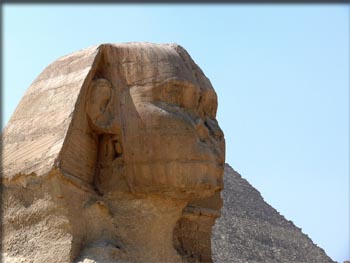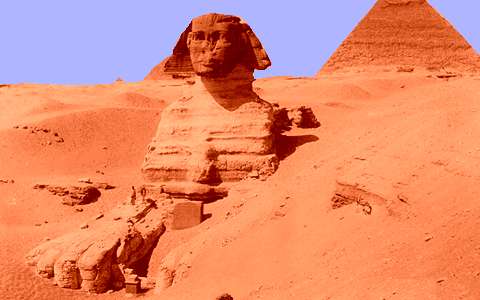pop up description layer
HOME
Cryptozoology UFO Mysteries Aviation Space & Time Dinosaurs Geology Archaeology Exploration 7 Wonders Surprising Science Troubled History Library Laboratory Attic Theater Store Index/Site Map Cyclorama
Search the Site: |
|
The Riddle of the Great Sphinx
Your fearful form is the work of the deathless gods. To spare the flat and fertile lands they placed you in your depression. A rocky island from which they banished the sand. They placed you as a neighbor to the pyramids...Who vigilantly watches the blessed Osiris... -Inscription from the second century A.D. After 25 centuries the history of the great Sphinx at Giza was so forgotten that many believed it had been placed in its position, as guardian of the pyramids, by the Gods. Indeed, the Sphinx is such an impressive work one, even today, might easily believe it must have been created by supernatural means. The statue, with a man's head and a lion's body, stands 66 feet (20m) high and 240 feet (73m) long. The head measures 19 feet (18m) from forehead to chin. Each paw extends 56 feet forward of the body. The face is over 6 yards wide. The lion was a powerful symbol in ancient Egypt as it represented strength and courage. The great cat was also considered the supreme guardian and tamed lions sometimes accompanied kings into battle. Not just as a mascot, but as the physical presence of a god meant to protect troops. The Sphinx was the combination of two symbols, a lion god, and the king pharaoh/god, into one icon. In fact, the Great Sphinx at Giza probably bears the face of the ruling pharaoh at the time of construction: Khafra (Also known as Chephren). The name "Sphinx" is probably not the orgianal name of this statue (which is thought to be the oldest monumental sculpture in the world). The term "Sphinx" comes from Arabic and means The Terrifying One, or quite literally, the Father of Dread.
The symbol wasn't limited to Egypt, but was also found in ancient Phoenician, Syrian, and Greek societies. In Greek legend, the Sphinx devoured all travelers who could not answer the riddle it posed: "What is the creature that walks on four legs in the morning, two legs at noon and three in the evening?" The hero Oedipus gave the answer, "Man," causing the Sphinx's death. The Great Sphinx at Giza started as a natural outcropping of rock. The ancient Egyptians carved the giant statue into the limestone around 2500 B.C.. To make it even taller than the height of the outcrop they chipped out a depression around the base of the statue. The paws were constructed from stone blocks. The entire statue was painted in ancient times: red for the face and body, yellow with blue stripes on the headress. Finally, a temple was built in front of the statue as a place visitors could offer gifts to the "living image" of the creature the Egyptians sometimes referred to as "Horus-in-the-Horizon." Thutmose IV's Dream As time passed the statue was given less attention and, after a few centuries, desert sands covered the Great Sphinx up to its neck. Legends claim that visitors would press their ear to the statue's lips seeking wisdom. Around 1400 B.C. a Egyptian prince, on a hunt, came to rest in the shadow of the Sphinx. While napping he heard the Sphinx tell him it would make him ruler of Egypt ahead of his older brothers if he promised to clear the sand away. On waking the prince vowed to keep the bargain. Sure enough, as the story goes, he ascended the throne as Pharaoh Thutmose IV and quickly had the statue uncovered.
Historians beleive that Thutmose IV concocted the dream to cover up murder. Thutmose had his brother killed so that he could gain the crown. While the Egyptian people might not have been able to forgive Thutmose the slaying for personal gain, they could overlook it if it seemed like it was the will of the gods. By the 19th century, when European archaeologists started taking a close look at Egyptian monuments, the statue was again covered up to it's neck in sand. Efforts to uncover and repair the statue were undertaken early in the 20th century. Preservation work continues even today. Unknown Passageways? There have been rumors of passageways and secret chambers surrounding the Sphinx and during recent restoration work several tunnels have been re-discovered. One, near the rear of the statue extends down into it for about nine yards. Another, behind the head, is a short dead-end shaft. The third, located mid-way between the tail and the paws, was apparently opened during restoration work in the 1920's, then resealed. It is unknown whether these tunnels were constructed by the original Egyptian designers, or were cut into the statue at a later date. Many scientists speculate they are the result of ancient treasure hunting efforts. Several attempts have been made to use non-invasive exploration techniques to ascertain if there are other hidden chambers or tunnels about the Sphinx. These include electromagnetic sounding, seismic refraction, seismic reflection, refraction tomography, electrical resistivity and acoustical survey tests. Studies made by Florida State University, Waseda University (Japan), and Boston University, have found "anomalies" around the Sphinx. These could be interpreted as chambers or passageways, but they could also be such natural features as faults or changes in the density of the rock. Egyptian archaeologists, charged with preserving the statue, are concerned about the danger of digging or drilling into the natural rock near the Sphinx to find out if cavities really exist. Despite close study much about the Great Sphinx remains unknown. There are no known inscriptions about it in the Old Kingdom, and there are no inscriptions anywhere describing its construction or its original purpose. In fact, we do not even know what the buiders of the Sphinx actually called their creation. So the riddle of the Sphinx remains, even today.
Copyright Lee Krystek 1997-2016. All Rights Reserved. |
|
Related Links |
|
|






